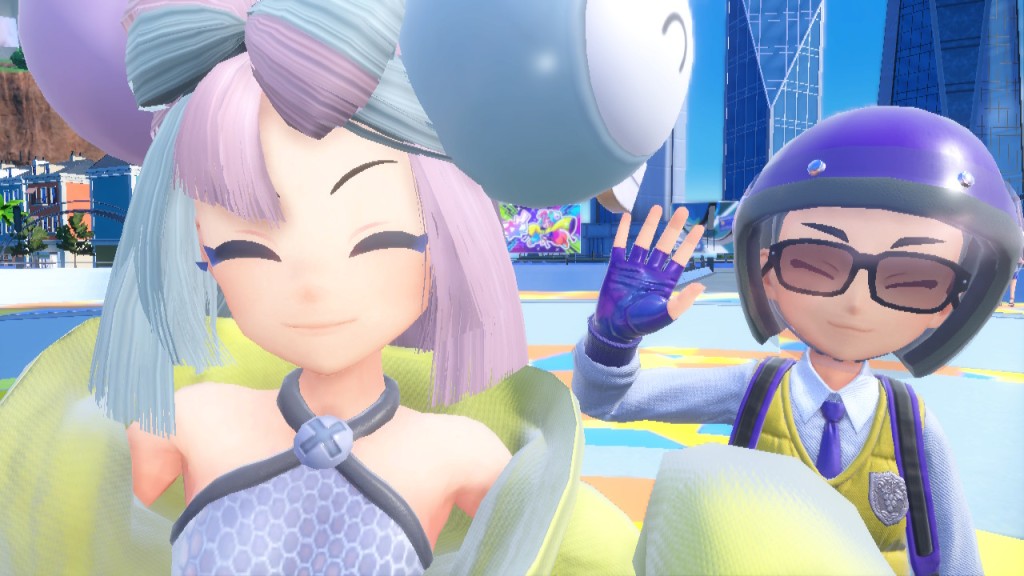
I’ve been a Pokémon fan since before the very first game launched in the US, and I have to say that playing Pokémon Violet is some of the most fun I’ve ever had with the franchise. Yes, I know about the glitches and lack of polish. I got stuck in a black void inside my own house right at the start of the game, and I’ve taken note of the wonky physics. But even though I’ve finished the main game, I still keep jumping in.
Similar to Pokémon Legends: Arceus, Pokémon Scarlet and Violet are open-world games, meaning that they emphasize freely exploring the environment without forcing you into a certain order of doing things. This is both a plus and minus, personally: I have felt that newer Pokémon games are a little too on-rails, and this is a way to break with that trend, but I’m rather directionally challenged both in real life and in games. Luckily, they’ve added things that make the world feel pretty navigable even for someone like me. One key concept shared with Legends: Arceus is to have a ridable Pokémon that replaces the idea of key TMs or HMs to traverse unusual terrain—a definitely welcome change.
The new region, Paldea, is based on Spain. Here, you enter a Pokémon school that places heavy emphasis on both searching for and pursuing your dreams. To that end, there are three separate but overlapping storylines that each emphasize somewhat different views of what it means to thrive in the world: Victory Road, Path of Legends, and Starfall Street. Their stories progress in compelling ways, involve meeting great new characters, and even act somewhat as tutorials to help you develop certain skills.
Victory Road feels the most refined, being the most tried-and-true part of Pokemon singleplayer. It’s the familiar acquiring of gym badges in order to fight against the Elite Four and become a champion, but it also manifests in cultural aspects of Paldea that result in a unique experience. Whereas Gym Leaders in other games dedicate their lives to running their gyms, it’s more of a side job here. Paldean Gym Leaders include a baker, a streamer, an office worker, a rapper, a sushi chef, and so on. Gym battles take place outdoors—perhaps as a way to not have to model interiors, but it nevertheless adds to the feel that Paldea isn’t like other regions.
Adding to this is maybe the most fun rival to ever appear in Pokémon. Nemona is a fellow student, but she’s already a Champion-rank trainer by the time you meet her. Rather than growing alongside you, she guides you to become stronger, all because she loves Pokémon battles so much that she’ll seize any opportunity to have a great match. Players online have compared her to Goku from Dragon Ball, and it’s quite apt.
The storylines in Path of Legends (where you pursue titanic Pokemon) and Starfall Street (where you fight against school delinquents who comprise the latest nefarious organization, Team Star) have really engaging plots full of interesting developments. I found my view of certain characters evolve over time, and they provide both some of the most heartfelt moments and some of the funniest gags I’ve ever experienced in Pokémon. One downside is that I think the gameplay elements they each emphasize could have been done in somewhat more exciting ways. The Titan Pokémon could feel more titanic, and there really isn’t much to the battle system used for taking down Team Star. They’re more good than bad, though.
Playing through all three paths is very rewarding, not only because it opens up new branches and brings the overall plot together, but also because they collectively convey the richness of Paldea. The region seems to move at a characteristic pace (at its Own Tempo, one could say) that is about loving life and enjoying good food, while the blossoming of aspirations, the learning of mythology, and the reassessment of assumptions create a feeling that this is a robust world with lots of history and personality.
As for the Pokémon themselves, appealing to those who prefer a more classic look and those looking for more bizarre designs. Nothing is as off-the-wall as the Ultra Beasts of Pokemon Sun and Moon, but they expand the series’s universe in interesting ways. One quirky thing is the abundance of Pokémon based on food, whether it’s Fidough the dog bread dog, Garganacl the living salt golem, or Scovillain the two-headed pepper plant, culinary creatures are a norm. The game also has a feature where you can make sandwiches and visit restaurants that confer certain bonuses, driving home the idea that Paldea is a land of gourmets—an idea heavily promoted by Spain’s own tourism industry, incidentally.
Compared to Pokémon Legends: Arceus, one thing that’s missing is the greater sense of experimentation with the gameplay mechanics. That game really turned key aspects on their heads, and it was refreshing in a way. I do understand keeping the game more turn-based and rooted in established elements like the implementation of speed and status effects and even agree that this was the right choice for a main Pokémon title. That said, I can see it being a little tedious for those who want something more different.
Pokémon Scarlet and Violet certainly have flaws, but there’s an undeniable charisma that makes me want to keep playing. Witnessing the myriad stories unfold is fun. Venturing out into the world is fun. Finding and learning about Pokémon is fun. Meeting new characters and discovering what makes them tick is fun. And growing alongside everyone is fun. I don’t know how long I’ll stick around, but I’ll consider it time well spent.